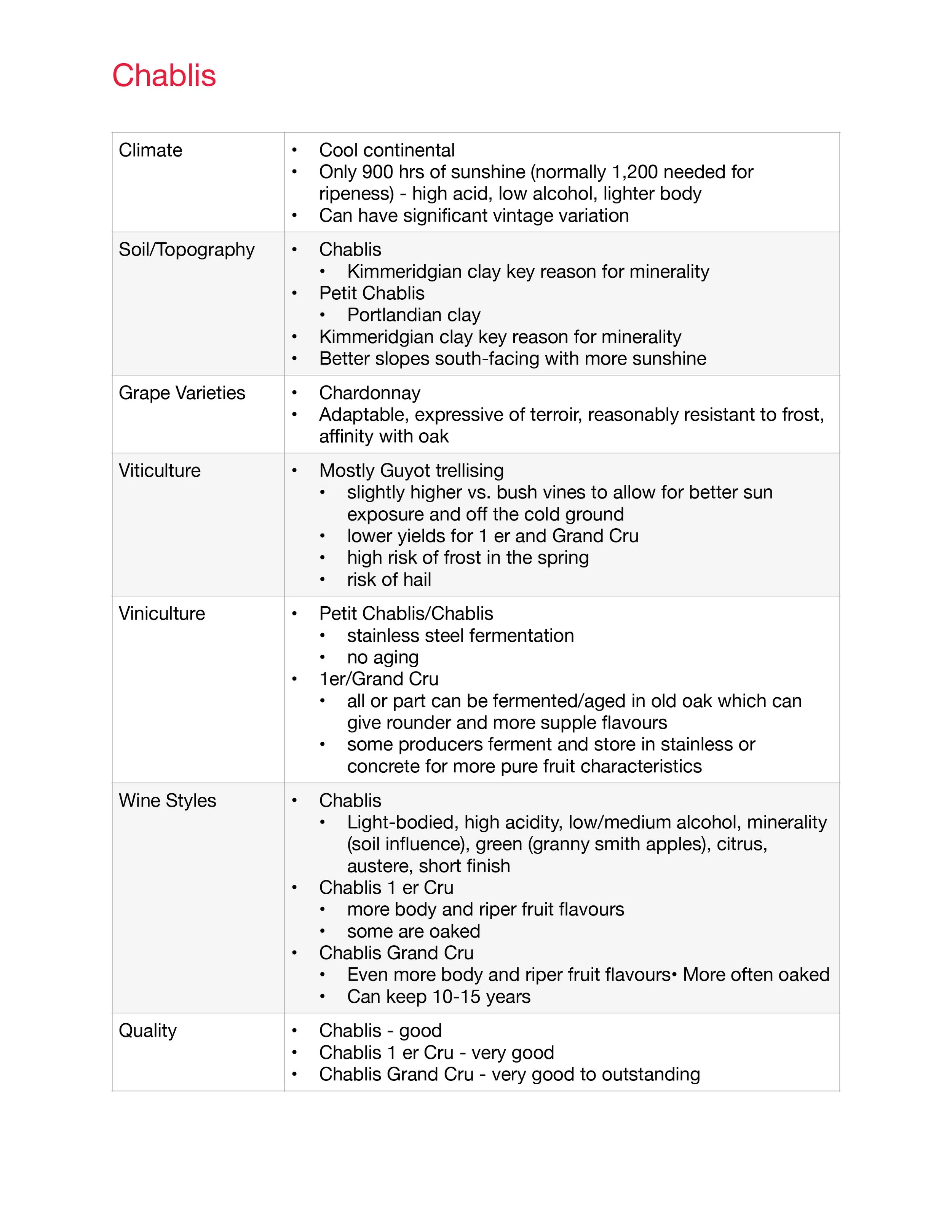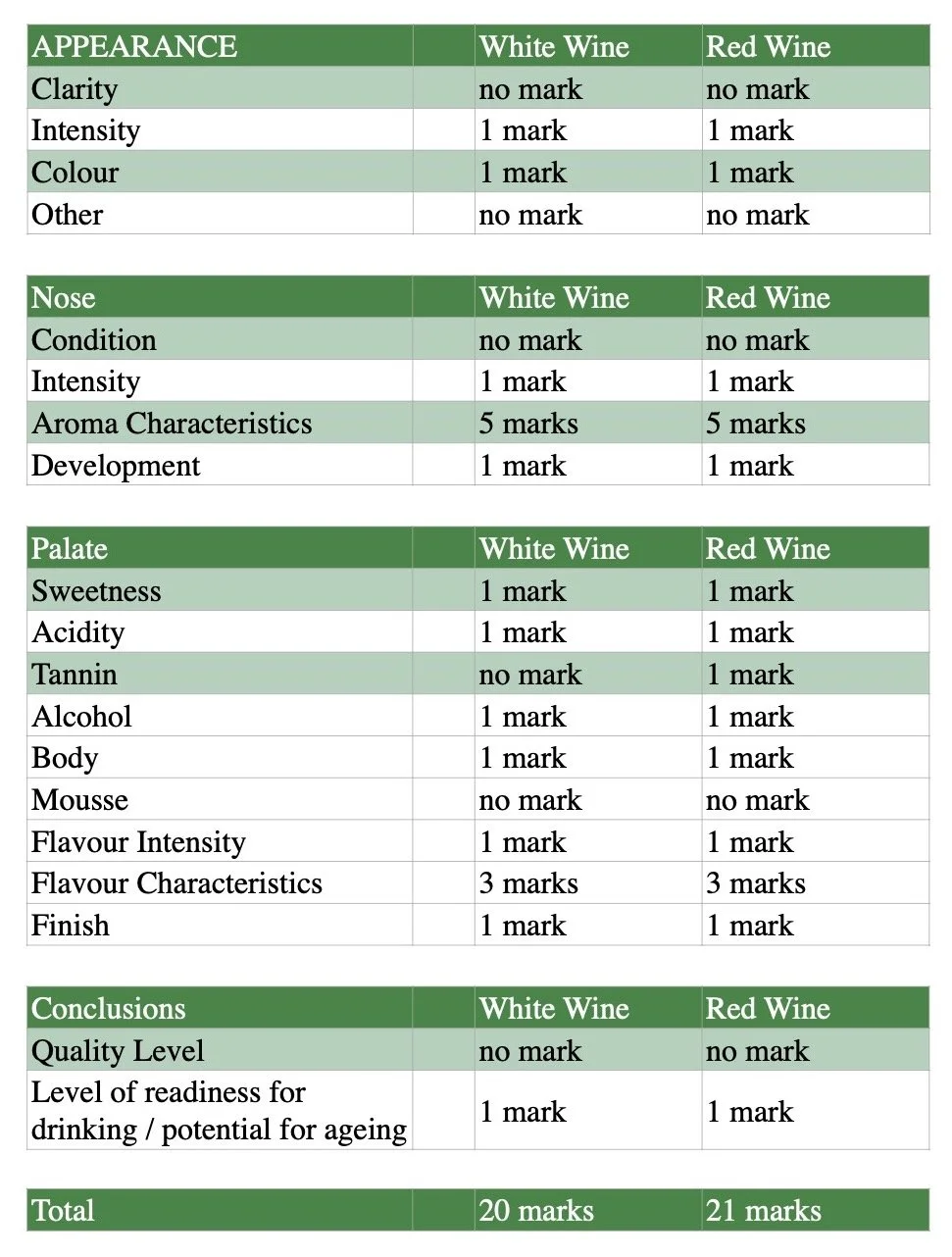
Theory and Practical
WSET Level 3 Award in Wines
As you progress from Level 1 through Level 3, the depth of knowledge increases. In Level 1, it’s all about exploring new concepts. In Level 2, you need to understand these concepts. By the time you get to Level 3, you need to be able to explain these concepts.
Although the volume of information is daunting, the goal of WSET Level 3 Award in Wines is to help you explain how climate, soil/topography, grape varieties, vineyard management, and winemaking processes impact the quality and content of the final product in the glass. All of the facts you must learn should be framed in this context.
For example, it is not enough to know that the flagship red grape of Central Otago is Pinot Noir. You must know how that extreme low latitude, continental climate, and diurnal temperature range produce a high alcohol and fruit forward expression of the grape.
Regions
There are five elements that you need to learn about for each region: climate, soil/topography, grape varieties, viticulture and winemaking. As well, for each key wine in the syllabus, you should be able to say why wine A is qualitatively and stylistically different than wine B. When you study for the WSET Level 3 and especially for the short answer questions, you need to be able to understand and form all these connections for each of the key wines in the syllabus..
To help your with your studies, we are showing you one way to structure your notes for each of the key regions in the syllabus. This way you know you have information on all the key variables. You can also use flash cards or create your own system. But the key is to have a system.
Theory
As with regions, pulling together something for grape growing and winemaking will help you manage the information.
Viti/Vini
1. Which one of the following statements is true?
a. The timing of the harvest is unaffected by rainfall
b. Only manual harvesting is suitable for premium quality wines
c. Grapes harvested by machine do not need to be destemmed
d. Mechanical harvesters are ideally suited to working on steep slopes
2. Wines made from Baga typically have the following characteristics.
a. pale colour, low tannin
b. pale colour, high tannin
c. deep colour, low tannin
d. deep colour, high tannin
3. Which of the following is a category in South Africa's Wine of Origin scheme.
a. Zone
b. Sub-region
c. Ward
d. AVA
4. Salt in food can make a wine seem
a. more bitter and less acidic
b. less bitter and less acidic
c. more bitter and more acidic
d. less bitter and more acidic
5. What is the minimum period of maturation in oak required for a Spanish red to be labelled Reserva?
a. 6 months
b. 12 months
c. 18 months
d. 36 months
Answers: 1-C, 2-D, 3-C, 4-B, 5-B
Sample Multiple Choice Questions
Part 1
a. Chardonnay can grow in both cool and warm climates. Give an example of one cool climate region and one warm climate region in Australia where Chardonnay is grown and describe what impact the climate has on the fruit characteristics of the grapes
Sample Short Answer Questions
An excellent answer would look like this:
Cool Climate: Tasmania is a region with a cool climate. Here, the grapes don't become overly ripe and as a result, the grapes develop apple and citrus aromas.
Warm climate: Margaret River has a warm climate. Here the grapes are able to ripen more than in a cool climate region and therefore wines display riper aromas of tropical fruit such as banana and pineapple.
Cool Climate: Tasmania. Wines have aromas of apple and citrus.
Warm Climate: Margaret River. Wines have aromas of pineapple and pineapple.
A less successful answer would be:
b. Vertical shoot positioning (VSP) is a trellising system often used when growing Chardonnay in a cool climate. Explain why a grape grower would choose to use this system.
In a cool climate grapes can struggle to ripen fully, A grape grower can help the grapes to ripen by increasing their exposure to sunlight and heat.
In VSP, the shoots are trained up the wires, meaning that the grapes are not shaded by any shoots that might otherwise hang down. Their exposure to sunlight and heat is therefore maximized.
An excellent answer would look like this:
In a cool climate VSP exposes the fruit to more sunlight and heat.
A less successful answer would be:
Part 2
Some Chardonnays can have pronounced aromas of hazelnut, butter, sweet spice, toast and vanilla with a rich texture and a full body.
a. Identify and describe two techniques that could be used during winemaking and maturation to achieve these characteristics. Explain what characteristic(s) each technique contributes to this style of wine.
Techique 1: Malolactic Fermentation is a process that happens immediately after the alcoholic fermentation has finished. Bacteria convert the malic acid in the wine to lactic acid. This lowers the acidity in the wine and can also contribute to buttery aromas in the wine.
Technique 2: To produce the pronounced aromas of sweet spice, toast and vanilla, a winemaker would use new small oak barrels. The juice could be put into barrels during the fermentation and/or the wine could be put into barrels during maturation. Older or large wooden vessels would not give these pronounced aromas. Oak can also add tannin to white wines, which can increate the texture and body of the wine.
An excellent answer would look like this:
Technique 1: Malolactic Fermentation lowers the acidity in the wine and can also contribute to the buttery aromas to a wine.
Technique 2: Oak barrels can be used during both winemaking and maturation. They can add a lot to a wine. They can add a range of flavours to the wine, which include vanilla, sweet spice and toast.
A less successful answer would be:
b. A customer asks you to recommend a premium French Chardonnay that has pronounced aromas of hazelnut, butter, sweet spice, toast and vanilla with a rich texture and a full body.
What wine would you recommend and at what temperature would you serve it?
I would recommend a Pouilly Fuissé and serve it lightly chilled.
An excellent answer would look like this:
I would recommend a white Burgundy and serve it chilled.
A less successful answer would be:
c. The wine above has been opened but not all of it was consumed. You want to preserve the remainder for a greater period of time than a few days. Name one appropriate method for preserving the wine and briefly explain how it works.
One method is the vacuum seal, A pump sucks most of the air out of the bottle of wine. This removes the oxygen, which would cause the wine to oxidize. Therefore the wine will last longer.
An excellent answer would look like this:
A vacuum system sucks the air out of the bottle protecting the wine from going off.
A less successful answer would be:
The final exam includes a blind tasting of two wines - one red and one white. While you may think it crazy to memorize a set of wine terms, you still need to do it. Tasting notes are all about letting someone else know what the wine tastes like, so "smells like my grandmother's basement" isn't appropriate. Does your grandmother's basement smell musty or does it smell of fresh laundry? While what you are smelling may remind you of your grandmother's basement, it is just too personal a term to use.
As a result, it is very important that you learn the Systematic Approach to Tasting (SAT) inside and out.
Wine Tasting
Here are some tips to help you:
Below are some great tips that will help you learn the SAT and write great tasting notes!
Practice! Practice! Practice!
Use acronyms!
Appearance: Clarity - Intensity - Colour - Other
Nose: Condition - Intensity - Aroma Characteristics - Development
Palate: Sweetness - Acidity - Tannin - Alcohol - Body - Intensity - Flavour Characteristics - Other - Finish
Conclusion: Quality - Readiness to Drink - Identity - Price
There are four categories for everything but palate. There are nine categories for palate.
If you remember all this, then the SAT will become second nature.
Practice writing your wine paragraph
WSET doesn't care if you use the same format for ever wine or whether you are wildly creative in your writing style as long as you get the points down. Here is a sample template for a tasting note:
Appearance
This wine is clear and of ________ ________ colour.
2 Marks
Nose
On the nose, the wine is clean with ________ intensity. It has primary aromas of ________, secondary aromas of ________, and tertiary aromas of ________. The wine is ________ (development).
Palate
On the palate, the wine is ________ and has ________ acidity, ________ tannin, ________ alcohol and is ________-bodied. It has ________ flavour intensity with primary flavours of ________, secondary flavours of ________, and tertiary flavours of ________. The finish is ________.
7 Marks
Conclusions
This wine is of ________ quality. You can ________ (readiness for drinking).
9/10* Marks
2 Marks
*Red wines receive one additional mark for describing tannins.
Appearance
This wine is clear and of deep ruby colour.
2/2 Marks
Nose
On the nose, the wine is clean with medium intensity. It has primary aromas of red currant, raspberry, kirsch, green pepper and violet. The wine is youthful.
Palate
On the palate, the wine is dry and has medium acidity, low tannins, medium alcohol and is light-bodied. It has medium flavour intensity with primary flavours of red currant, cranberry, kirsch, green pepper and violet. The finish is medium.
7/7 Marks
10/10 Marks
Conclusions
This wine is of good quality, You can drink it now. It is not suitable for aging or further aging.
2/2 Marks
Tasting note that receives full marks
This is a note for a good quality youthful red wine with low tannins and no oak influence. This wine shows only primary aromas and all available marks are given for valid primary descriptors only. Notice how every section is filled in. You can't get a point if you leave something out! And remember to use descriptors and not clusters (blossom not floral, vanilla not oak, almond not deliberate oxidation). No marks can be rewarded for clusters.
Appearance
This wine is clear and of medium lemon colour.
2/2 Marks
Nose
On the nose, the wine is clean with medium + to pronounced intensity. It has primary aromas of lemon, peach, pineapple and flint and secondary notes of butter and vanilla.
Palate
On the palate, the wine is dry and has moderate+ acidity - high acidity, moderate alcohol and is moderate-bodied. It has primary flavours of apple and peach and secondary flavours of vanilla. The finish is long.
4/7 Marks
6/9 Marks
Conclusions
This wine is of outstanding quality. You can drink it now. but it has potential for aging.
2/2 Marks
Tasting note that doesn't receive full marks
This note is for an outstanding quality white wine that has 14% abv showing development (tertiary aromas/flavours) with clear oak influence (secondary aromas and flavours). For the nose, one mark is given for a valid primary, secondary and tertiary aroma with two marks allocated to any other valid descriptors. For the palate, there are only three marks allocated, one for each of valid primary, secondary and tertiary flavours. Can you figure out what's missing in this note?
Intensity can’t be a range
One mark each for primary aromas
One mark for oak influence
No tertiary aroma given
Acidity can’t be a range
Missing intensity
One mark for primary aroma
One mark for secondary aroma
No tertiary aroma was given
One thing we can't stress enough is to be logical in your conclusions! A wine that has a low acidity, no tannins and little intensity of flavours CANNOT be a wine with aging potential. Similarly, a wine without balance and with a short finish can not be described as outstanding.
Simple Wines
Simple wines. Wines that have aromas and flavours which are neutral, generic or lacking distinct varietal expression may be described as simple.
If the wine is simple, you will receive one mark for stating this as one of your aroma descriptors. You will also receive one mark for stating the wine is simple as part of the flavour characteristics. To gain full marks for aroma or flavour characteristics, you must identify a simple wine as such on the nose and palate in addition to giving other correct descriptors.
Example of a Note for a Simple Wine - Pinot Grigio
This wine is clean with medium - intensity. It’s a simple wine with primary aromas of pear, apple, lemon and grapefruit aromas.
7/7 Marks
You must indicate the wine is simple for a mark
There are no secondary or tertiary aromas
Marking Scheme - Points allocation
Determining Wine Quality
In WSET Level 3 you will not asked to provide justification for your answer concerning the quality level of the wine, but how exactly do you determine quality. There are four factors that together are known as BLIC.
Balance
Length
Intensity
Complexity
If the wine scores highly on all of these components, you can be comfortable with an answer of very good to outstanding. This is an objective exercise. Notice that determining quality doesn't take into effect one's personal preferences. If you are not a fan of big jammy wines, but the wine still scores highly on all of these factors, it is a very good to outstanding wine despite your not liking it.





